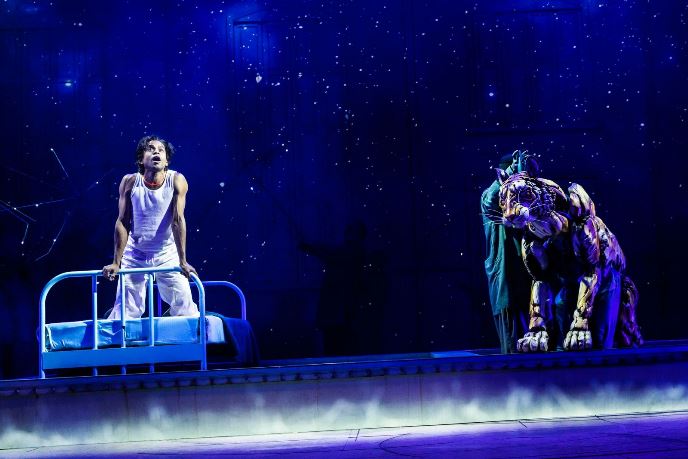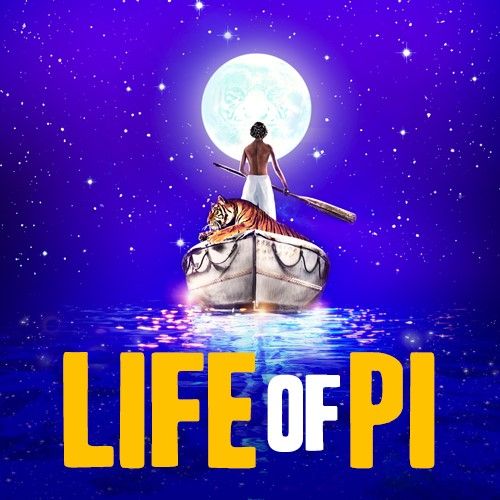Canadian novelist Yann Martel’s Life of Pi, an epic adventure of man versus nature, continues to have a long and successful life across continents and genres. The original book, which sold more than ten million copies worldwide since its publication in 2001, was reincarnated on both the stage and screen – first, in 2012, in an eleven-time Oscar-nominated and four-time Oscar-winning feature film adapted by screenwriter David Magee and directed by Ang Lee, then in a stage version by Lolita Chakrabarti, which made its debut in Sheffield, England in 2019, and transferred to London’s West End in 2021, where it won five Olivier Awards, including Best New Play. It has now transferred to Broadway for a limited engagement at the Schoenfeld Theatre, and it’s sure to garner even greater popularity and more acclaim for its astonishing artistic design and compelling lead performance.

The gripping memory play, set in 1976-78, recounts the tale of sixteen-year-old Pi Patel, growing up in Pondicherry, India, with his sister and parents, who run the local zoo. Because of the growing civil unrest in their homeland and the decreasing number of visitors to the zoo, his father decides to relocate the family and animals to Canada via a Japanese cargo ship. But as they traverse the Pacific Ocean, they become shipwrecked in a raging storm that kills everyone on board except Pi, a zebra, hyena, orangutan, and Bengal tiger named Richard Parker (for a reason that won’t be revealed here), who escape on a lifeboat, then soon dwindle down (after the other three are killed and eaten) to just Pi and the tiger – a carnivorous companion he must learn to tame.
After 227 days adrift at sea with little food or water, they are washed ashore on a beach in Mexico, where Richard Parker runs off into the jungle and the traumatized and delirious Pi is taken to a hospital and interrogated about his experience as the ship’s sole survivor (the device in which the go-back narrative is framed) by a Japanese- and a Canadian-based official, who don’t believe his story. He then offers them another version (again, no spoiler here) and lets them decide which one they prefer, raising questions about how facts, truth, and reality are perceived, reimagined, and presented, and the importance of storytelling, metaphor, and religion to get through suffering the cruel hardships of life, with the remark: “And so it goes with God.”

Directed by Max Webster, the action moves back and forth between Pi’s hospital room and enactments of the situations he describes, all brought vividly to life by Hiran Abeysekera, who delivers a fully three-dimensional characterization of Pi (played by Adi Dixit at all Tuesday performances), with believable emotion and psychology. The stellar performance is supported by a featured cast and ensemble of nearly two dozen – Brian Thomas Abraham, Rajesh Bose, Nikki Calonge, Mahnaz Damania, Fred Davis, Avery Glymph, Jon Hoche, Mahira Kakkar, Kirstin Louie, Rowan Ian Seamus Magee, Jonathan David Martin, Usman Ali Mughal, Uma Paranjpe, Salma Qarnain, Betsy Rosen, Celia Mei Rubin, David Shih, Sathya Sridharan, Daisuke Tsuji, Sonya Venugopal, Scarlet Wilderink, and Andrew Wilson – including a masterful team of puppeteers who inhabit and animate the animals and give voice to their familiar sounds (puppet design by Nick Barnes and Finn Caldwell, with puppetry and movement direction by Caldwell).

Most breathtaking is the show’s extraordinary scenic design (by Tim Hatley) that astonishes with its stagecraft and transitions seamlessly from one scene to another, leaving the audience to wonder how they did it. The busy colorful marketplace in India (with the company in a variety of equally colorful and identifying costumes, also designed by Hatley, with wigs by David Brian Brown) unexpectedly becomes the grey and desolate ship, the lifeboat suddenly appears before our eyes, and Pi jumps into the ocean and becomes fully immersed, only to have his head resurface at other points from below, with projections on the dry floor and upstage wall (video design and animation by Andrzej Goulding), sound (by Carolyn Downing), and lighting (by Tim Lutkin) evoking the water, waves, and turbulent storm, as well as the clear and wondrous night sky filled with stars.

Despite all of Pi’s metaphysical ponderings, philosophizing about religion and the nature of reality, and proselytizing about the existence of God, what is never answered is why survival should be dependent upon the deaths of other living creatures, be they animal or human. As an animal lover and vegetarian (as was the young Pi, raised Hindu), that’s an issue that I found disturbing in the often brutally violent play and its expressed message (“my story will make you believe in God”). Life of Pi, aside from delighting with its theatrical prowess, will leave you thinking about the many profound questions it raises.
Running Time: Approximately two hours and five minutes, including an intermission.
Life of Pi plays through Sunday, July 23, 2023, at the Schoenfeld Theatre, 236 West 45th Street, NYC. For tickets (priced at $74-268, plus fees), go online. Masks are no longer required but are recommended.





